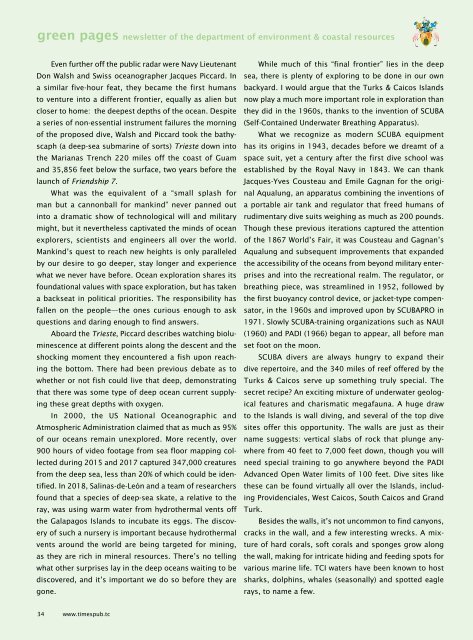Times of the Islands Winter 2020/21
Presents the "soul of the Turks & Caicos Islands" with in-depth features about local people, culture, history, environment, real estate, businesses, resorts, restaurants and activities.
Presents the "soul of the Turks & Caicos Islands" with in-depth features about local people, culture, history, environment, real estate, businesses, resorts, restaurants and activities.
You also want an ePaper? Increase the reach of your titles
YUMPU automatically turns print PDFs into web optimized ePapers that Google loves.
green pages newsletter <strong>of</strong> <strong>the</strong> department <strong>of</strong> environment & coastal resources<br />
Even fur<strong>the</strong>r <strong>of</strong>f <strong>the</strong> public radar were Navy Lieutenant<br />
Don Walsh and Swiss oceanographer Jacques Piccard. In<br />
a similar five-hour feat, <strong>the</strong>y became <strong>the</strong> first humans<br />
to venture into a different frontier, equally as alien but<br />
closer to home: <strong>the</strong> deepest depths <strong>of</strong> <strong>the</strong> ocean. Despite<br />
a series <strong>of</strong> non-essential instrument failures <strong>the</strong> morning<br />
<strong>of</strong> <strong>the</strong> proposed dive, Walsh and Piccard took <strong>the</strong> bathyscaph<br />
(a deep-sea submarine <strong>of</strong> sorts) Trieste down into<br />
<strong>the</strong> Marianas Trench 220 miles <strong>of</strong>f <strong>the</strong> coast <strong>of</strong> Guam<br />
and 35,856 feet below <strong>the</strong> surface, two years before <strong>the</strong><br />
launch <strong>of</strong> Friendship 7.<br />
What was <strong>the</strong> equivalent <strong>of</strong> a “small splash for<br />
man but a cannonball for mankind” never panned out<br />
into a dramatic show <strong>of</strong> technological will and military<br />
might, but it never<strong>the</strong>less captivated <strong>the</strong> minds <strong>of</strong> ocean<br />
explorers, scientists and engineers all over <strong>the</strong> world.<br />
Mankind’s quest to reach new heights is only paralleled<br />
by our desire to go deeper, stay longer and experience<br />
what we never have before. Ocean exploration shares its<br />
foundational values with space exploration, but has taken<br />
a backseat in political priorities. The responsibility has<br />
fallen on <strong>the</strong> people—<strong>the</strong> ones curious enough to ask<br />
questions and daring enough to find answers.<br />
Aboard <strong>the</strong> Trieste, Piccard describes watching bioluminescence<br />
at different points along <strong>the</strong> descent and <strong>the</strong><br />
shocking moment <strong>the</strong>y encountered a fish upon reaching<br />
<strong>the</strong> bottom. There had been previous debate as to<br />
whe<strong>the</strong>r or not fish could live that deep, demonstrating<br />
that <strong>the</strong>re was some type <strong>of</strong> deep ocean current supplying<br />
<strong>the</strong>se great depths with oxygen.<br />
In 2000, <strong>the</strong> US National Oceanographic and<br />
Atmospheric Administration claimed that as much as 95%<br />
<strong>of</strong> our oceans remain unexplored. More recently, over<br />
900 hours <strong>of</strong> video footage from sea floor mapping collected<br />
during 2015 and 2017 captured 347,000 creatures<br />
from <strong>the</strong> deep sea, less than 20% <strong>of</strong> which could be identified.<br />
In 2018, Salinas-de-León and a team <strong>of</strong> researchers<br />
found that a species <strong>of</strong> deep-sea skate, a relative to <strong>the</strong><br />
ray, was using warm water from hydro<strong>the</strong>rmal vents <strong>of</strong>f<br />
<strong>the</strong> Galapagos <strong>Islands</strong> to incubate its eggs. The discovery<br />
<strong>of</strong> such a nursery is important because hydro<strong>the</strong>rmal<br />
vents around <strong>the</strong> world are being targeted for mining,<br />
as <strong>the</strong>y are rich in mineral resources. There’s no telling<br />
what o<strong>the</strong>r surprises lay in <strong>the</strong> deep oceans waiting to be<br />
discovered, and it’s important we do so before <strong>the</strong>y are<br />
gone.<br />
While much <strong>of</strong> this “final frontier” lies in <strong>the</strong> deep<br />
sea, <strong>the</strong>re is plenty <strong>of</strong> exploring to be done in our own<br />
backyard. I would argue that <strong>the</strong> Turks & Caicos <strong>Islands</strong><br />
now play a much more important role in exploration than<br />
<strong>the</strong>y did in <strong>the</strong> 1960s, thanks to <strong>the</strong> invention <strong>of</strong> SCUBA<br />
(Self-Contained Underwater Breathing Apparatus).<br />
What we recognize as modern SCUBA equipment<br />
has its origins in 1943, decades before we dreamt <strong>of</strong> a<br />
space suit, yet a century after <strong>the</strong> first dive school was<br />
established by <strong>the</strong> Royal Navy in 1843. We can thank<br />
Jacques-Yves Cousteau and Emile Gagnan for <strong>the</strong> original<br />
Aqualung, an apparatus combining <strong>the</strong> inventions <strong>of</strong><br />
a portable air tank and regulator that freed humans <strong>of</strong><br />
rudimentary dive suits weighing as much as 200 pounds.<br />
Though <strong>the</strong>se previous iterations captured <strong>the</strong> attention<br />
<strong>of</strong> <strong>the</strong> 1867 World’s Fair, it was Cousteau and Gagnan’s<br />
Aqualung and subsequent improvements that expanded<br />
<strong>the</strong> accessibility <strong>of</strong> <strong>the</strong> oceans from beyond military enterprises<br />
and into <strong>the</strong> recreational realm. The regulator, or<br />
breathing piece, was streamlined in 1952, followed by<br />
<strong>the</strong> first buoyancy control device, or jacket-type compensator,<br />
in <strong>the</strong> 1960s and improved upon by SCUBAPRO in<br />
1971. Slowly SCUBA-training organizations such as NAUI<br />
(1960) and PADI (1966) began to appear, all before man<br />
set foot on <strong>the</strong> moon.<br />
SCUBA divers are always hungry to expand <strong>the</strong>ir<br />
dive repertoire, and <strong>the</strong> 340 miles <strong>of</strong> reef <strong>of</strong>fered by <strong>the</strong><br />
Turks & Caicos serve up something truly special. The<br />
secret recipe? An exciting mixture <strong>of</strong> underwater geological<br />
features and charismatic megafauna. A huge draw<br />
to <strong>the</strong> <strong>Islands</strong> is wall diving, and several <strong>of</strong> <strong>the</strong> top dive<br />
sites <strong>of</strong>fer this opportunity. The walls are just as <strong>the</strong>ir<br />
name suggests: vertical slabs <strong>of</strong> rock that plunge anywhere<br />
from 40 feet to 7,000 feet down, though you will<br />
need special training to go anywhere beyond <strong>the</strong> PADI<br />
Advanced Open Water limits <strong>of</strong> 100 feet. Dive sites like<br />
<strong>the</strong>se can be found virtually all over <strong>the</strong> <strong>Islands</strong>, including<br />
Providenciales, West Caicos, South Caicos and Grand<br />
Turk.<br />
Besides <strong>the</strong> walls, it’s not uncommon to find canyons,<br />
cracks in <strong>the</strong> wall, and a few interesting wrecks. A mixture<br />
<strong>of</strong> hard corals, s<strong>of</strong>t corals and sponges grow along<br />
<strong>the</strong> wall, making for intricate hiding and feeding spots for<br />
various marine life. TCI waters have been known to host<br />
sharks, dolphins, whales (seasonally) and spotted eagle<br />
rays, to name a few.<br />
34 www.timespub.tc

















